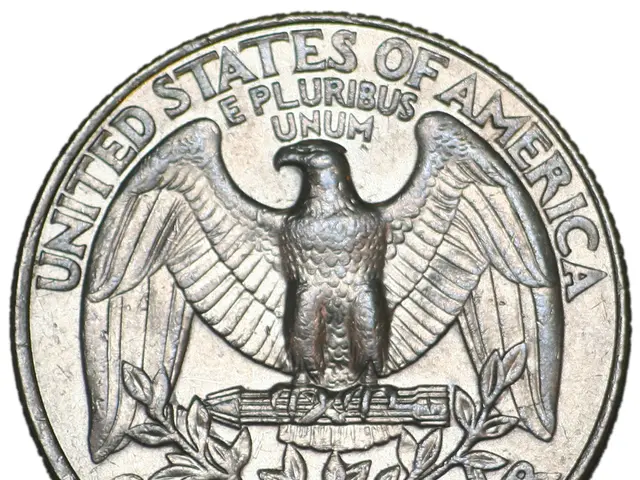U.S. economy experiences contractions due to sudden policy changes from Trump administration
New Article:
In a recent blow to the US economy, Q1 of 2025 saw a significant dip as President Donald Trump's aggressive policy changes rattled consumers and businesses alike. Gross domestic product, which measures the nation's production of goods and services, recorded an annualized rate of -0.3%, the Commerce Department revealed on Wednesday.
This downturn is a stark contrast to the fourth quarter's 2.4% rate and far worse than the projected 0.8%, thereby marking the economy's worst performance since 2022. GDP is adjusted for seasonal fluctuations and inflation. The market responded with a slump following the release of the GDP report.
The Trump administration has embarked on a chaotic tariff spree over the past few months, escalating trade tensions with China and causing unease among Americans. Many economists warn that Trump's ambitious drive to reshape global trade could lead to soaring inflation in the United States and even trigger a recession.
However, President Trump deflected blame from the weak figures reported in the economy's first report card of his second term, attributing the sluggish performance to the "Biden 'Overhang.'"
The decline in economic growth at the start of the year was primarily driven by a wider trade deficit, due to Americans preemptively purchasing goods to avoid trade tariffs, and cuts in government spending, according to the report. Imports skyrocketed from -1.9% in the fourth quarter to 41.3% in the first three months of the year, while exports registered at a 1.8% rate.
When imports exceed exports, this subtracts from GDP, and it was the single largest drag on growth in the first quarter. The difference between imports and exports subtracted from GDP by the most on records dating back to 1947.
Trump's top trade adviser, Peter Navarro, viewed the GDP report as "the best negative print I have ever seen in my life." Navarro suggested that the markets should look beyond the surface, pointing to the sharp increase in domestic investment last quarter. However, much of this came from businesses increasing their inventories ahead of tariffs, according to the Commerce Department.
Consumer spending, which powers about 70% of the US economy, slowed notably in the first quarter to a 1.8% rate, down significantly from 4% in the prior three-month period. This slowdown was primarily due to Americans reducing their spending on goods, marking the weakest rate since mid-2023. Government spending also weighed on the economy, with federal outlays dropping to -5.1% from 4% during the same period.
In a positive development, final sales to private domestic purchasers – a key gauge of underlying demand in the economy – accelerated to 3% in the first quarter from 2.9% in the fourth quarter. The uptick in business investment is "not what firms do when they're concerned about the economic outlook," according to Stephen Miran, chair of the White House's Council of Economic Advisers.
Inflation took a sharper than expected jump during the first quarter. The Personal Consumption Expenditures price index rose an estimated 3.6% for the quarter, well above the 2.4% during the fourth quarter, according to the report. Excluding food and energy prices, the core PCE index increased 3.5% compared to 2.6% the quarter before.
Despite the recent economic slump, the US is not necessarily in the throes of a recession yet. A recession is defined as a broad-based contraction in the economy that lasts for more than a few months, encompassing the labor market, consumer spending, industrial activity, and business investment. Unemployment remains relatively low, businesses are continuing to invest in their operations, and consumers have not retreated significantly with their spending, according to government data.
However, economic growth could take a turn for the worse if Trump accelerates his tariff blitz further. According to Gregory Daco, chief economist at Ernst & Young, "I don't think we can call a recession from this data right now, but it is a sign that we're on this razor-thin edge where the longer the tariffs remain in place, the more likely we are headed for an economic downturn."
A separate report released on Wednesday showed a steep drop-off in hiring by businesses in the US private sector, which does not bode well for future economic growth. Employers added just 62,000 jobs in April, far below the 147,000 jobs added in March. "Unease is the word of the day," said Nela Richardson, chief economist at ADP. "Employers are trying to reconcile policy and consumer uncertainty with a run of mostly positive economic data."
In summary, recent analyses of Trump's 2025 tariff policies predict severe economic impacts across GDP, household finances, and inflation. These impacts include a potential 6% long-term GDP reduction, annual consumer losses of $3,800, and a 2.3% price level increase, among others. The official recession arbiter, the National Bureau of Economic Research, has yet to determine whether the US is in a recession, although the possibility remains as the tariff situation continues to unfold.
- The economic slowdown in Q1 of 2025, with a -0.3% GDP rate, can be attributed to President Donald Trump's aggressive tariff policies that caused a wider trade deficit and unease among Americans.
- Many economists warn that Trump's tariff spree could lead to soaring inflation, potential recession, and a long-term GDP reduction of up to 6%.
- Businesses have increased their inventories ahead of tariffs, contributing to the uptick in domestic investment in the first quarter, but this does not signal a positive outlook for the industry or economy, according to Stephen Miran, chair of the White House's Council of Economic Advisers.
- The US economy, while not technically in a recession yet, could face further economic downturn if Trump accelerates his tariff blitz, as suggested by Gregory Daco, chief economist at Ernst & Young. The official recession arbiter, the National Bureau of Economic Research, has yet to determine whether a recession has occurred.







